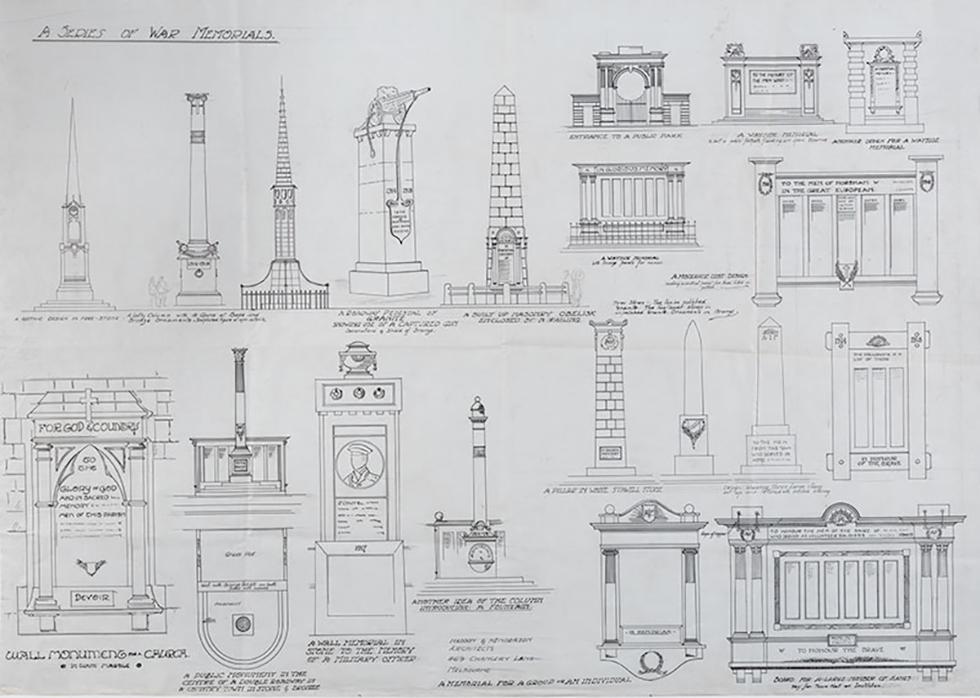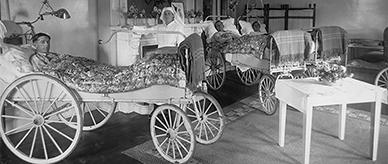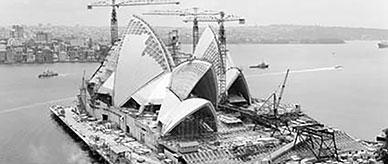


Transcript
[This document contains 22 images of war memorial designs. Each design has a note underneath. All text is handwritten.]
A SERIES OF WAR MEMORIALS. [underlined.]
[As read from the top left quarter of the page. From left to right, the text under the first 5 images is as follows; labelled 1 – 5 for reader clarity.]
[1. Image is a tall thin pillar coming to a pointed top. Captioned:] A GOTHIC DESIGN IN FREE-STONE.
[2. Image shows 2 human figures standing at the base of a tall pillar. The pillar has a flat top. Captioned:] A lofty Column with 4 Guns at base and Bronze Ornaments – Sculpted figure at apex suitable.
[3. Image shows a tall pillar with a brick-like pattern, coming to a pointed top. No caption.]
[4. This image shows a tall column with a plaque on the front and a Gatling gun atop the column. The plaque on the front reads 'TO THE ARMIES OF AUSTRALIA WHO SAVED AMIENS'. Captioned:] A ROADWAY PEDESTAL OF GRANITE SHOWING USE OF A CAPTURED GUN. Decorations and Shield of Bronze.
[5. This image shows a tall, slightly angled pillar with a pointed top, The pillar's sides have a brick-like pattern, and there is a large plaque at the lower portion of the column. The pillar is surrounded by a low fence. pillar with a brick-like grid pattern, surrounded by a fence. Captioned:] A BUILT UP MASONRY OBELISK ENCLOSED BY A RAILING.
[From left to right, the text under the 3 images of the first row at the top right quadrant is as follows; labelled 6 - 8 for reader clarity]
[6. This image shows a large gateway. There are two smaller side gates and a large centre gate framed by two pillars on each side. Captioned: ENTRANCE TO A PUBLIC PARK
[7. This image shows a wide plaque with a column framing either side. The plaque has the text 'TO THE MEMORY OF THE MEN WHO …'. Captioned:] A WAYSIDE MEMORIAL To suit a public footpath flanking an open Reserve.
[8. This image shows a tall plaque framed by 2 columns. The plaque has the text 'IN PERPETUAL MEMORY...'. Captioned:] ANOTHER DESIGN FOR A WAYSIDE MEMORIAL[.]
[From left to right, the text under the 2 images in the second row at right top quadrant is as follows; labelled 9 - 10 for reader clarity]
[9. A wide piece with 6 long thin spaces for name listing and 2 columns on either side. It is surrounded by a fence. A header plaque on the memorial reads 'IN GLORIOUS MEMORY'. Captioned:] A WAYSIDE MEMORIAL With Bronze panels for names.
[10. A wide piece with 5 long thin spaces for name listing and 1 column on either side. The central panel has the heading 'THOSE WHO DIED ON ACTIVE SERVICE', while the four other panels have the heading 'NAMES'. A horizontal panel at the top of the design reads 'TO THE MEN OF HORSHAM W... IN THE GREAT EUROPEAN...] Captioned:] A MODERATE COST DESIGN making a central panel for those killed in action.
[From left to right, the text under the 4 images in the bottom left quadrant of the page is as follows; labelled 11 - 14 for reader clarity.]
[11. This image shows a brick wall with a plaque on it. Caption reads:] Wall Monument for a church. In white marble. [text on memorial design reads: 'For God & Country. To The Glory of God and In Sacred... Memory... Men of This Parish'.]
[12. This image has 2 parts. Upper part shows a rectangular shaped construction with 4 spaces for name lists and a tall pillar rising from the centre. Below shows a birds-eye view of the placement of the monument within a semi-circular shaped courtyard. Caption reads:] A Public Monument in the centre of a double roadway in a country town in stone and diorite.
[13. This image shows a pillar style monument, with an urn atop and space for the image of a defence serviceman and details on the front of the pillar. Caption reads:] a wall memorial in stone to the memory of a military officer.
[14. Image shows 3 stairs leading to the monument with a tall pillar rising from the right side of the roof. Caption reads:] Another idea of the column. Introducing a fountain. [underlined.]
[From left to right, the text under the memorial design, in the right lower quadrant is as follows; images are labelled 15 – 18 for reader clarity.]
[images 15 – 18 are all for 1 design.]
[15. This image shows a column with a wide top, a brick-like grid pattern and a plaque near the base. Caption reads:] A pillar in white Stawell stone.
[16. Image shows a simple pillar, with a wreath around a plaque. Text above image reads:] Three stones: The top in polished granite. The two lower stones in unpolished granite. Ornaments in bronze.
[17. This image shows a pillar with a pyramid style top. There is writing on the base. Caption reads:] Design showing three large stones set up and lettered with incised lettering. [text on pillar reads: 'To the men from this town who served in arms...']
[18. Image shows a wall mount design, with space for 3 columns of name lists. No text underneath image.] [text on memorial reads: 'the following is a list of those...' and 'In honour of the brave'.]
[From left to right, the text under the 2 designs, second row of lower right quadrant is as follows; labelled 19 - 20 for reader clarity.]
[19. Image shows a wall with space for a place, framed by 2 pillar-like structures. Caption reads:] A memorial for a group or an individual. [text on design reads: 'In memoriam'.]
[20. Image shows a large structure, with space for 6 thin tall name lists and 2 columns on either side. Caption reads:] Board for a large number of names. Say for Town Hall or institution. [text on memorial design reads: 'To honour the men of the shire of … who served as volunteer soldiers...' and 'To honour the brave'.]
Haddon and Henderson Architects
469 Chancery Lane
Melbourne
Related themes
Need help with your research?
Learn how to interpret primary sources, use our collection and more.


